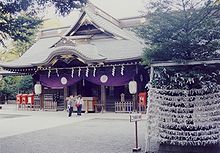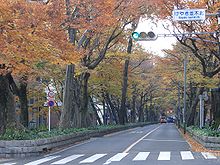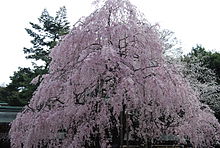- Ōkunitama Shrine
-
Ōkunitama Shrine (大国魂神社 Ōkunitama Jinja) is a shrine located in Fuchu, Tokyo Japan. It is the central shrine of Musashi province, and six shrines was united, especially it is one of the five suit-and-tie Shinto shrines Tokyo Great Shrine (東京大神宮 Tōkyō dai jingū), Yasukuni Shrine, Hie Shrine, Meiji Shrine.
Contents
General description
It has long history from 111. Kurayami matsuri is famous as one of the three debauched religions in Kanto region, in precincts there is a marriage-hall, it is known as god of marriage. It located in the center of the city. In a precincts there are many houses, Honden (本殿), Haiden (拝殿), Matuo jinjya (松尾神社), Tatsumi jinja (巽神社), Tohsho-gu (東照宮), Jyuyojyo (授与所), Machiai-jyo (待合所), Sumiyoshi jinjya (住吉神社), Ohwashi jinjya (大鷲神社), Kagura-den (神楽殿), Hohmotsu-den (宝物殿), Suzaku-mon (中雀門), Cho-zu sha (手水舎), Kairoh (廻廊), Shamu-sho (社務所), marriage-hall, drum tower, Zui-shin-mon (随神門), Chukon-hi (忠魂碑), Japanese-Russo War victory memory, ring used in sumo, Miyanome shrine, Inari shrine (稲荷神社), Baba-daimon, Goryo-jo (御旅所)…etc. It located in the capital of Musashi lang syne,[1]
Kurayami matsuri
The Kurayami matsuri (くらやみ祭り Black festival) was one of the three debauched religions in Kanto region. Annually his ceremonial hold between 4 April to 6 May. Originally this fete was Utagaki'' ( 歌垣 promiscuous copulation ),[citation needed] Ryotaro Shiba, literary magnate in Japan, noted disorderly meeting of this ceremonial in his own work.[2] He delineated that the men and women, it contained marrieds, met in this precinct, and had a swinger party at outdoors stark darkness during the festival period. But in meiji era, facing criticism by Christian missionaries and visiting foreign educators and engineers, the constituted authorities inhibited these meetings. These traditions were rooted out and gangshay is not held now. Consequently this festival termed Kurayami matsuri, Kurayami means blackness and Matsuri imports festival in Japanese. Originally it was held midnight, then changed the time at evening at 1959. In 5 May, at zelkova serrate line of trees old style derby is hold, and Huchu Bayashi (march) was played, 4 May 20 pageant marches was hold. On the 5th May leaded 6 big tambour, 8 carrying of miniature shrines carried to Goryo-jyo. After the mikoshi is carried out, theceremonial is held, the next day the mikoshi is brought back to the shrine. For carrying was hold in the darkness, it term as Kurayami matsuri. Some years ago refrain voluntarily from Tokyo horse race, but in 2007 it was held.
History
- 111(Established by Emperor Keikō in 41年)
- 111 founded 5 May
- 645(Taika)It became Saijyo of Kokuga (国衙) in Musashi, and it central shrine of Musashi.
- ? Six shrine was honored, the name called Musashi-sousha rikusho-guh.
- 1062: Minamoto no Yoriyoshi and his son, Minamoto no Yoshiie donated thousand of sapling of zelkova.
- 1182: Minamoto no Yoritomo made an invocation of his wife's safe delivery.
- 1186: Minamoto no Yoritomo build the shrine pavilions.
- 1590: Tokugawa Ieyasu donated 500 koku and build the shrine pavilions.
- 1646: the shrine pavilion was burned out.
- 1167: Tokugawa Ietsuna build the shrine pavilions.
- 1872: The name of shrine changed as Ohkunitama jinjya.
- 1875: It appointed as Fuken-sha .
- 1886: It appointed as Kanhei-shosha.
According to history of shrine, Keigyo tennoh (the 12th Mikado) established 5 May AD. 41. The offspring of Noomiame-no-hohino-mikoto (出雲臣天穂日命) appointed to Musashi Kuni no miyatsuko and rendered a service for shrine, successive miyatsukos have done same work. In Taika no kakushin at 645, Kokuhu of Musashi seted in this place, and Sha changed to Saijyo of Kokuga, and Kokushi render a service, it became the place sum up the Saimu in Japan.
See also
 Media related to Okunitama-jinja, Fuchu at Wikimedia Commons
Media related to Okunitama-jinja, Fuchu at Wikimedia Commons
List of Research papers for
Kurayami matsuri and Ohkunitama shrine
- 中里 亮平 2009 Matsuri boom and influence on festivals: the case of the kurayami-matsuri festival at Okunitama shrine in Fuchu, Tokyo. The Japanese folklore review (24), 47-60.
- 中里 亮平 2008 Festivals and Influential members of the community: the case of the Kurayami-matsuri Festival at Okunitama shrine in Fuchu-shi, Tokyo. The Japanese folklore review (23), 51-64.
- Tsuruga Eisuke 2007 Possibility on recovery of the humanity, concerned with festival reciprocity : Through the Fuchu Kurayami Matsuri reserches. Education for sustainable development 6, 105-112.
- Mogi Sakae, Shimada Kiyoshi 1989 The Kurayami Matsuri at Okunitama Shrine in Fuchu Transaction of the institute for Japanese culture and classics 64, 140-207,
- 杉浦 翔子 2006 A study of the chief priest system of the plum wine drinking ritual held at Owari-no-Okunitama Jinja 『皇学館論叢』 39(6), 36-63,
- Koide Goro 1983 On Argonauta argo Housed in the Okunitama Shrine.『ちりぼたん』 14(1), 21.
Utagaki
- 糸永 正之 2009 Utagaki in Bhutan: the verification of face-to-face interaction through fixed-verse songs. Asian folk culture studies (8), 1-32.
- Nittamachi Yoshinao 1997 The Symbolism of The Expression in Touka. Research memoirs of the Kobe Technical College 35, 89-94.
- Miyazaki Takeshi 1997 A Study of a Traditional Event Utagaki in Tsugaru Area.7 『日本歌謡研究』 37, 73-83.
References
External links
- Official website (Japanese)
Shinto shrine Shinto architecture Buildings - chōzuya or temizuya
- haiden
- heiden
- hokora
- honden / shinden / shōden
- kagura-den
- massha
- sessha
Architectonic elements Styles - hirairi-zukuri
- tsumairi-zukuri
- gongen-zukuri
- hachiman-zukuri
- hiyoshi-zukuri
- irimoya-zukuri
- ishi-no-ma-zukuri
- kasuga-zukuri
- kibitsu-zukuri
- misedana-zukuri
- nagare-zukuri
- ōtori-zukuri
- owari-zukuri
- ryōnagare-zukuri
- shinmei-zukuri
- sumiyoshi-zukuri
- taisha-zukuri
Others Implements Main kami Staff Head shrines1 - Fushimi Inari Taisha
- Usa Hachiman-gū
- Ise Grand Shrine
- Dazaifu Tenman-gū
- Munakata Taisha
- Suwa Taisha
- Hiyoshi Taisha
- Kumano Nachi Taisha
- Tsushima Shrine
- Yasaka Shrine
Miscellaneous 1 (in order of the size of the shrine network they head)
Categories:- Wikipedia articles needing cleanup after translation
- Jingū
- Shinto shrines in Tokyo
- Anthropology
- Sex festivals
Wikimedia Foundation. 2010.




